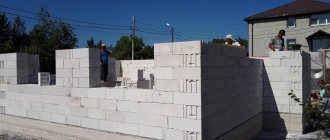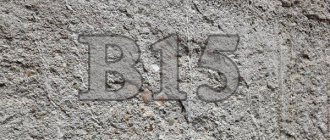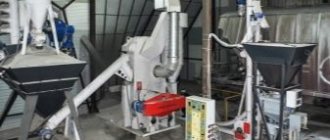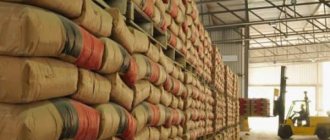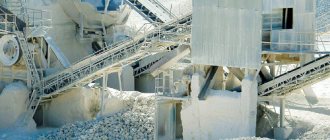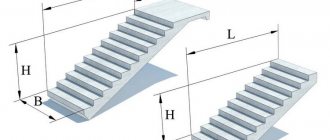Cellular concrete is a porous building material, which is produced on the basis of mineral substances and siliceous porous aggregates. This material belongs to the light varieties of concrete and is characterized by the presence of air pores, which makes it quite light and warm. The porous structure of the material is formed due to gas formation and mixing of light aggregates with foam. Cellular concrete is used in construction for insulating structures and for erecting walls.
Cellular concrete must be manufactured in accordance with the approved GOST 25485, which defines its physical and mechanical characteristics:
- density;
- compressive strength;
- bending and tensile strength;
- frost resistance;
- ability to retain heat;
- average humidity;
- ability to retain moisture;
- drying shrinkage percentage.
Classification
According to GOST 25485, cellular concrete is divided into types:
- cement (the mixture contains 50% cement);
- limestone (with lime content up to 50%, gypsum or slag up to 15%);
- mixed (with cement 15-50%, lime and slag);
- ash (with the presence of ash more than 50%);
- slag (with slag content up to 50%).
By poration method:
- gas generation method;
- foaming method;
- aeration method.
According to their functional purpose, cellular concrete is divided into:
- thermal insulation;
- structural and thermal insulation;
- structural.
Thermal insulation is used in construction only as insulation, since it has a low load-bearing capacity. Its specific gravity is 300-500 kg per cubic meter. m.
Structural thermal insulation is durable and is used in the construction of interior partitions and walls that do not bear any load. The specific gravity of the material is 500-900 kg per cubic meter. m.
Structural cellular material is considered the strongest of cellular concretes with a high degree of thermal conductivity. Can be used for the construction of permanent walls of buildings. The specific gravity of this type of concrete is 100-1200 kg cubic. m.
Cellular concrete can be autoclaved or non-autoclaved.
- Autoclave. For hardening, a large area container with thick sealed walls is used, in which a vacuum is created and the required temperature is maintained.
- Non-autoclave. To harden the mixtures, steaming, natural and other drying methods are used.
Strength and other properties
Mechanical parameters:
Comparative table of characteristics of foam concrete and ordinary concrete
- mass - determined by density, one cubic meter weighs from 400 to 1200 kg;
- maximum compressive strength - up to 160 kg/cm2 for aerated concrete, up to 90 kg/cm2 for foam concrete;
- water absorption - 20% of its own weight for aerated concrete, 14% for foam concrete;
- resistance to cold - up to 100 freeze/defrost cycles.
The thermal conductivity of both of these materials is quite low: the solid wall warms up right through and begins to transfer heat into the room only after 8 hours - towards the end of daylight.
The strength of cellular concrete blocks, due to the porous structure, is lower than that of traditional bricks. But this is balanced by its reduced mass, thereby reducing the load on the foundation. This material is strong enough to be used to make external walls of buildings, but is not recommended for use if the floors in the house are made of reinforced concrete.
Foam and aerated concrete - comparison
Gas foam concrete has good vapor permeability. Such a block “breathes” better than brick, so fungus and mold do not grow on the inner surfaces of the walls. Disadvantages include high moisture absorption, which is why the bottom of the external wall has to be waterproofed.
And also a disadvantage of walls made of aerated concrete blocks is the low soundproofing qualities of this material. Only double-layer walls provide an acceptable barrier to the propagation of sounds.
The sound insulation properties of foam concrete blocks are higher than those of aerated concrete blocks, since the volume of air pores and the total air content in them is greater.
Types of cellular concrete
There are 3 main types of cellular concrete:
- foam concrete;
- aerated concrete;
- gas silicate.
Foam concrete is made from cement mortar, to which a foam reagent consisting of many air bubbles is added. When thoroughly mixed, the material acquires a porous structure, and when it hardens, it turns into foam concrete. It is a non-autoclave cellular material.
Aerated concrete is made by mixing aluminum powder and cement mortar. These 2 components, when reacting, release hydrogen bubbles, increasing the initial volume of the mixture by 5 times. The resulting mixture is formed into blocks and placed in autoclaves, where the material hardens. This material is called autoclave.
Gas silicate is a type of aerated concrete. It differs in that its composition may not contain cement at all or contain a minimal amount of it. A silicate mixture is used as a binder.
Application area
Cellular concrete of various grades is used for the construction and insulation of buildings (both residential and commercial). Due to its low dead weight, it is convenient for construction on soft soils, where structures made of brick or reinforced concrete give significant settlement.
Technology of laying a wall from aerated blocks
When facing a brick wall, there must be an air gap that is filled with mineral wool or another similar substance. This is necessary to level out the difference in the vapor permeability of these materials. Brick has worse vapor permeability than an aerated concrete block, which is why condensation will accumulate on the brick. As a result, this will lead to delamination of the brick and aerated concrete walls. Therefore, the gap must be laid in advance.
When laying, the blocks are held together not with cement, but with a special adhesive solution. The technology does not imply the use of vertical seams in the presence of a tongue-and-groove connection (the blocks are “clicked” from the sides to each other), but for strength, the load-bearing walls are reinforced with metal.
It is advisable to use foam concrete blocks for the installation of internal floors and partitions, and aerated concrete blocks for laying or cladding load-bearing walls.
Related video: What is cellular concrete
Publications on the topic
Determining the thickness of aerated concrete walls
Characteristics and possibilities of using Yutong aerated concrete blocks
Secrets of building a house from wood concrete with your own hands
Material composition
When producing cellular concrete, the required components are:
- Portland cement (not lower than M400);
- silicate limestone powder.
Other components and fillers may include:
- blast furnace slag (ground);
- quartz sand;
- dry ash;
- ferroalloy slags;
- foaming agent;
- gasifier – aluminum powder;
- superplasticizers;
- granular foamed polystyrene;
- mica;
- clay.
All fillers are added to the mixture in finely ground form. Their part in the total composition of the mixture is 20-40%. Porosization of the material is ensured by introducing aluminum powder and calcium chloride into the solution. The liquid used is water with a low salt content. To improve the properties of cellular concrete, foamed polystyrene and hardeners are added, the content of which in the total mass of the mixture is minimal.
Table 1 - Ratio of components to obtain 1 cubic meter. m. cellular concrete
| Main components | Concrete D400 | Concrete D600-D1000 | Concrete D800 |
| Portland cement | 300 kg | 325 kg | 390 kg |
| Sand or sludge | 120 kg | 205 kg | 335 kg |
| Gas or foaming agent | 850 g | 1.05 kg | 1 kg |
| Water | 155 l | 182 l | 225 l |
Production technology
Procedure for the production of aerated concrete
The prepared components are loaded into the mixer in the following order:
- ash or sand sludge;
- water;
- Portland cement, lime, aluminum powder.
Additional components (gypsum, surfactants) are introduced simultaneously with binders. Aluminum powder first goes through a degreasing process and is mixed with a surfactant.
Sludge and water must have a temperature of +35°C before being added to the general mixture - in this case, the reaction of aluminum and calcium chloride will be more active.
All components before loading the gas generator 1-3 minutes. mix thoroughly. After adding the blowing agent, the mixture is actively stirred for another 3-5 minutes.
When producing aerated concrete, swelling of the material occurs in a special form by heating the solution, adding a surfactant and mechanical action. At this stage, 2 methods are used: casting and vibration swelling. With the 2nd method, the gas-forming agent is distributed more evenly in the solution, and the mixture becomes homogeneous.
After the material has cooled, the “top” is removed, the concrete is cut into blocks of the required size and placed in an autoclave for final hardening.
The procedure for producing foam concrete
Foam concrete hardens naturally when the material is periodically moistened so that it does not crack during the drying process. In this case, the output is a porous mass.
The technological process consists of several stages:
- technical foam is made in a foam frother;
- water and fiberglass are mixed in a mixer, then cement and sand are added, everything is thoroughly mixed and technical foam is introduced;
- the resulting solution is stirred for 3 minutes;
- the finished foam concrete is poured into molds.
The products are dried under natural conditions for 2 days. Then remove from the molds, lay in rows and leave for another 2 weeks, periodically moistening.
2Normative references
This standard uses references to the following interstate standards:
GOST 4.212-80 System of product quality indicators. Construction. Concrete. Nomenclature of indicators
GOST 3476-74 Granulated blast furnace and electrothermophosphorus slags for cement production
GOST 4013-82 Gypsum and gypsum anhydrite stone for the production of binding materials. Specifications
GOST 5494-95 Aluminum powder. Specifications
GOST 7076-99 Construction materials and products. Method for determining thermal conductivity and thermal resistance under stationary thermal conditions
GOST 9179-77 Construction lime. Specifications
GOST 10178-85 Portland cement and Portland slag cement. Specifications
GOST 10180-90 Concrete. Methods for determining strength using control samples
GOST 12730.1-78 Concrete. Methods for determining density
GOST 12730.2-78 Concrete. Humidity Determination Method
GOST 12852.0-77 Cellular concrete. General requirements for test methods
GOST 13015-2003 Reinforced concrete and concrete products for construction. General technical requirements. Rules for acceptance, labeling, transportation and storage
GOST 18105-86 Concrete. Strength control rules
GOST 23732-79 Water for concrete and mortars. Specifications
GOST 24104-2001 Laboratory scales. General technical requirements
GOST 24211-2003 Additives for concrete and mortars. General technical conditions
GOST 25336-82 Laboratory glassware and equipment. Types, main parameters and sizes
GOST 25485-89 Cellular concrete. Specifications
GOST 25898-83 Construction materials and products. Methods for determining vapor permeation resistance
GOST 27005-86 Lightweight and cellular concrete. Average Density Control Rules
GOST 30108-94 Construction materials and products. Determination of specific effective activity of natural radionuclides
GOST 30244-94 Construction materials. Flammability test methods
GOST 30459-2003 Additives for concrete and mortars. Methods for determining effectiveness
GOST 31108-2003 General construction cements. Specifications
Note - When using this standard, it is advisable to check the validity of the reference standards using the “National Standards” index compiled as of January 1 of the current year, and according to the corresponding information indexes published in the current year. If the reference standard is replaced (changed), then when using this standard you should be guided by the replacing (changed) standard. If the reference standard is canceled without replacement, then the provision in which a reference is made to it is applied in the part that does not affect this reference.
